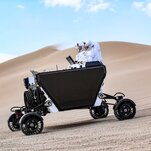
A Big Rover Aims to Be Like ‘U.P.S. for the Moon’
By contrast, Astrolab’s moon trip is, at least for now, an entirely commercial venture with no financing from NASA.
Mr. Matthews declined to say how much it would cost to get FLEX to the moon or how much money Astrolab has raised. He said Astrolab would make money by lifting and deploying cargo for customers on the lunar surface. That could include scientific instruments. In the future, the rover could help build lunar infrastructure.
“Essentially providing what I like to call last-mile mobility on the moon,” Mr. Matthews said. “You can kind of think of it like being U.P.S. for the moon. And in this analogy, Starship is the container ship crossing the ocean, and we’re the local distribution solution.”
A robotic arm on the rover can help set up the payload on the surface. The mass of the rover and all of the cargo will be more than two metric tons. The FLEX rover is a bit larger than NASA’s Perseverance rover on Mars and much faster, with a top speed of 15 miles per hour.
Mr. Matthews said Astrolab already had several signed agreements for payloads.
That appears to be part of the expanding potential market for Starship. SpaceX plans to use it for launching its second generation of Starlink internet communications satellites. Two flights that are to go past the moon (but not land) have already been chartered by wealthy space tourists. Mr. Musk’s long-term dream is for a fleet of Starships to carry settlers to Mars.

